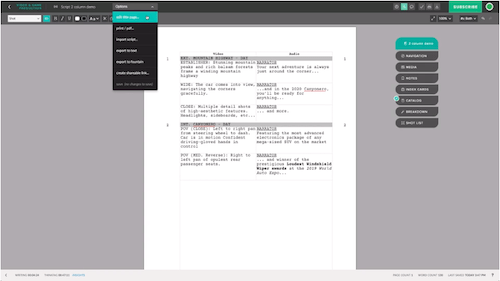- COPY AND PASTE THIS BLOG POST TEMPLATE INTO A NEW BLOG POST in YOUR BLOG
- TITLE THIS BLOG POST: Session # Year # Production Project, and REPLACE THE #’s
- LEAVE THE ONLY THE UPPERCASE HEADINGS IN THIS BLOG POST
- DELETE ALL OF MR. LE DUC’s INSTRUCTIONS, AFTER COMPLETING THEM
- REMOVE THE WORD TEMPLATE v.4 FROM THE TITLE in YOUR BLOG POST
- PLACE A CREATIVE COMMONS IMAGE RELATED TO THE PROJECT FROM OPENVERSE.ORG AT THE TOP OF THE POST
- FOLLOW THE DIRECTIONS IN THE:
- REVIEW THESE POST EXAMPLES FOR GUIDANCE:
- USE THE PTS, CLASS PROJECT TRACKING SHEET, FOR SOME CONTENT BELOW
- REFERENCE YOUR TEAM’s FORMS, IF THAT HELPS
- DELETE ALL OF MR. LE DUC’s INSTRUCTIONS DETAILED ABOVE AFTER COMPLETING THEM
SUMMARY – Due Dec. 9
Role
- Place your ROLE title here…
Intention (SMART Goal) for the Session
- Copy and paste your SMART Goal from the class PTS, Project Tracking Sheet, here…
PRE-PRODUCTION – INQUIRY – Due Dec. 13
LEADER(S) IN THE FIELD / EXEMPLARY WORK(S)
Primary Source
Embed a video of a good role model for YOUR ROLE this session. This is someone or an example of work that guides or inspires your SMART goal. Copy and paste this source from the PTS, Project Tracking Sheet. EXAMPLES: a director, songwriter, a great game, etc. Write a sentence describing why you chose this source.
Secondary Source
Embed a source explaining the PRIMARY SOURCE. Assume that the reader of your blog has no idea who or what the primary source is. Use the secondary source to explain and justify why the primary source is a good role model for this project. This could be a video essay or interview about the primary source. Write a sentence describing why you chose this source.
TRAINING SOURCE(S)
Embed your training source from YOUR SMART GOAL linked in the PTS, Project Tracking Sheet. Take notes and link back to time stamps within the video. Watch Mr. Le Duc’s Linked Notes Video, if you need help
PROJECT TIMELINE
Pre-production Milestones
Production Milestones
Post-production Milestones
PROPOSED BUDGET
Plan and include a personal budget for this project. Mr. Le Duc’s guidance on the parameters for this session is to see how much it would cost for you to be hired to do ‘your job’ or your role for this session. Add the estimated time you think you will spend on the project, research how much you should be paid by the hour, and include that total cost here.
EVIDENCE OF TEAM PLANNING AND DECISIONS
Place screenshots of the following…
- Storyboard (FILM) (with comments for each role) OR other planning documents like sketches, flowcharts (GAME DESIGN), song or lyric notes (ROCK), etc.
PRODUCTION – ACTION – Due Jan. 10
THE (FILM, SOUND, or GAME)
Embed or link the final version of the film, game, or song from your Google Drive (FILM & ROCK) or itch.io (GAME). Make sure it is publicly viewable.
Write a descriptive sentence about the embedded or linked project above.
SKILLS COMMENTARY
Link the team slideshow with your role, SMART Goal, and evidence of your SMART Goal for this session.
Write a sentence about your role in the slideshow and creative and technical contributions to the project.
POST-PRODUCTION – REFLECTION – Due Jan. 17
21st CENTURY SKILLS
Ways of Thinking (Creativity, Innovation, Critical Thinking, Problem Solving)
How did you grow in these areas during this project? Pick one and explain.
Ways of Working (Communication & Collaboration)
How did you grow in these areas during this project? Pick one and explain.
Tools for Working (Info & Media Literacy)
How did you grow in these areas during this project? Pick one and explain.
Ways of Living in the World (Life & Career)
How did you grow in these areas during this project? Pick one and explain.
REACTIONS TO THE FINAL VERSION
Place at least one comment from the PEER review and cite the student’s first name. Place at least one comment from the ADVISOR review and cite the student’s first name.
SELF-REFLECTION
Pick one of these types of reflection; action points, evaluative, intentional, or retrospective, state which one you picked, and write your reflection here…
GRAMMAR AND SPELLING
Place the name of the grammar and spelling tool you used to create this blog post.
EDITOR
Name the person who reviewed your blog post for grammar and spelling issues. First name only.
DID YOU DELETE ALL OF MR. LE DUC’s INSTRUCTIONS ABOVE? <— DELETE THIS INSTRUCTION, TOO 🙂 !!!










